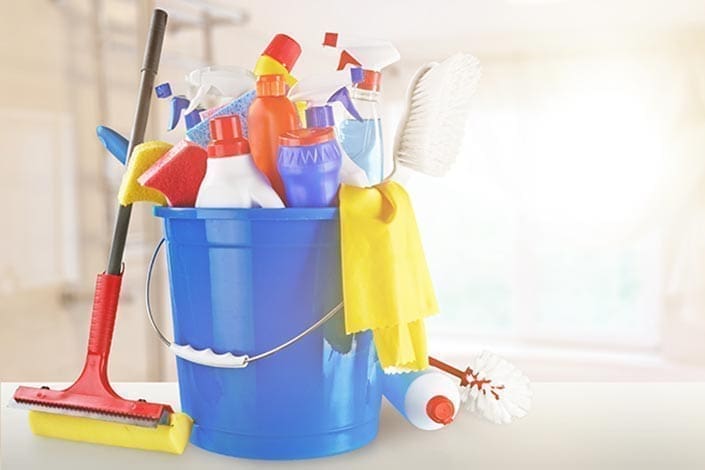
Cleaning your home isn’t just for looks. Cleaning and disinfecting your home are important for reducing the spread of germs and bacteria that cause infection and illness.
Path to caring for a healthy home
Many people recognized the importance of disinfecting their homes during the beginning of the COVID-19 pandemic. A recent survey by the American Cleaning Institute found 70% of Americans now view cleaning as a way to protect the health and safety of those in their homes, versus just thinking of cleaning as a chore. Cleaning has a more personal meaning.
Cleaning and disinfecting remain important year-round. Many common illnesses, such as colds and flu viruses, can be spread through surface contact.
What’s the difference between cleaning, sanitizing, and disinfecting?
Cleaning: This is the removal of unwanted contaminants, such as soil, dirt, and grease from your hands, a surface or another type of material. This usually involves using soap and water or a proper surface cleaner.
Sanitizing: This is the process of reducing the number of bacteria on a surface to levels considered safe by public health codes or regulations. It doesn’t necessarily mean you have eliminated the germs. But it does mean you have lowered the risk.
Disinfecting: This is the process of inactivating bacteria, viruses, and fungi that may cause infections and disease.
Things to consider
Don’t let the word “disinfect” overwhelm you. Keeping germs down to a minimum in your home is easier than you think with these tips:
- Common household touchpoints: Think of the things everyone in a household touches every day, multiple times through the day. These are the items that should be wiped down with an antibacterial solution. You can use premoistened wipes that include a bleach or non-bleach wipes made from an antibacterial solution. You can also spray similar solutions on a dry cloth to achieve the same results. But make sure you follow the label directions on what type of surfaces that product should and should not be used on.
- Electronics, such as TV remotes, gaming controls, and keyboards
- Phones, both landlines and mobile phones
- Handles on window blinds
- Faucets, toilet handles, and toilet lids
- Cabinet handles and countertops
- Doorknobs
- Storage containers, such as those used to store food, laundry products and cleaning supplies
- Baby changing tables
- Floors: Regularly vacuum carpets and mop hard surfaces, such as tile and wood floors.
- Bathrooms: Clean and disinfect everything in a bathroom, including toilets, sinks, counters, toilet paper dispensers, floors, showers, and tubs. It’s also a good idea to disinfect decorative items, such as tissue dispensers and toothbrush holders.
- Upholstered furniture and window treatments: Vacuum furniture and wash or dry clean window treatments, if possible. This does not have to be done weekly, but at least twice a year is helpful.
- Windows and window frames: This can be done with the use of cleaning wipes and window cleaner.
Other considerations
- When possible, open your windows to increase air flow through your home. Stagnant air allows germs to sit and expose others to illness.
- Remind yourself and your family to wash your hands after using the bathroom, cleaning, changing a diaper or caring for someone who is sick.
- Do some extra cleaning and disinfecting when someone in your home is sick.
- Keep up with the laundry, including bedding.
How to disinfect toys
Disinfecting toys with a porous surface, such as stuffed animals:
- If the item is machine washable, put it in a mesh laundry bag or pillowcase that is tightly secured at the top.
- Wash the item on the delicate cycle, using cold water and regular detergent or laundry sanitizer.
- Keep it in the mesh bag or pillowcase and dry it on a low setting.
Disinfecting toys with plastic or hard surfaces:
- Remove any dirt or soil by washing it with soap and water.
- Sanitize or disinfect with the toy with EPA-registered products, always reading the label to ensure proper use of the disinfectant.
- Let the disinfectant dry, then rinse the toy before returning it to the child. Toys that can be put in the mouth should be sanitized and rinsed between uses. Be careful not to have kids share toys in between cleanings. Frequently disinfect shared toys or play spaces.
Safety considerations
- Always store these products away from children. Keep these products in their original containers with the original safety labels.
- Don’t combine cleaning agents. Many cleaning solutions can be harmful to the skin or breathing when combined. Read and follow the labels on the back of the product for safety instructions and proper use.
- Ventilate the room when cleaning, if possible. Many cleaning solutions have strong odors that can bother users. Open a window or use a ceiling or room exhaust fan when cleaning.
- Consider wearing gloves when cleaning. Harsh chemicals can irritate your skin.
Questions to ask your doctor
- How often do I need to wipe down surfaces?
- Do I need to use bleach-based products?
- Is winter worse than spring for illness?
- Are professional cleaning services better than do-it-yourself cleaning?
- Can my pet bring bacteria and fungi into the home?
Resources
American Cleaning Institute: Cleaning is Caring Web Page
The development of this content was in collaboration with the American Cleaning Institute™.
![]()
Copyright © American Academy of Family Physicians
This information provides a general overview and may not apply to everyone. Talk to your family doctor to find out if this information applies to you and to get more information on this subject.




